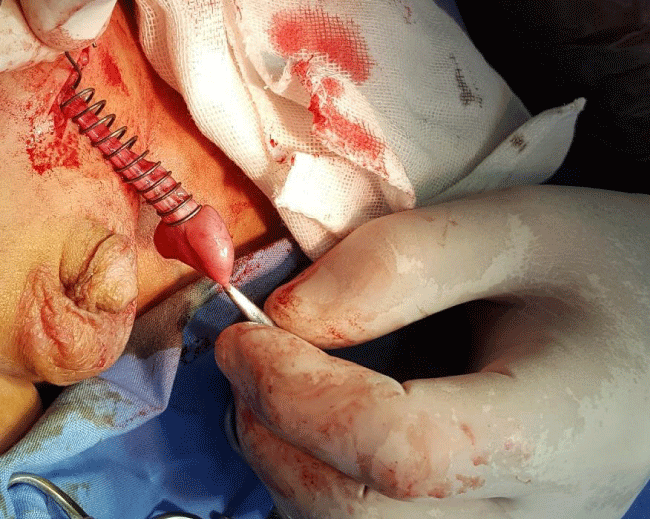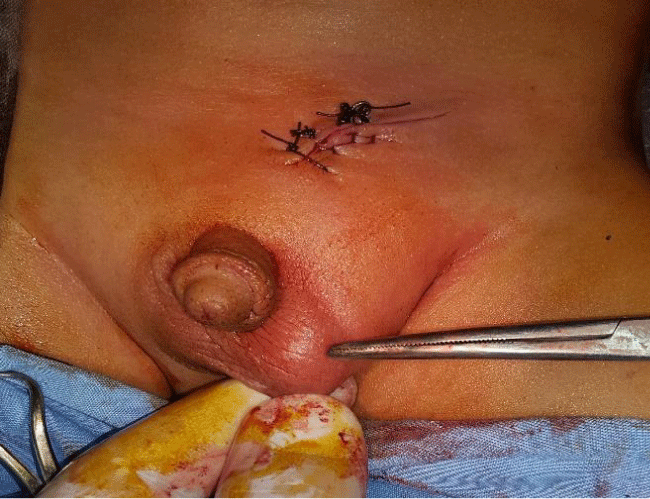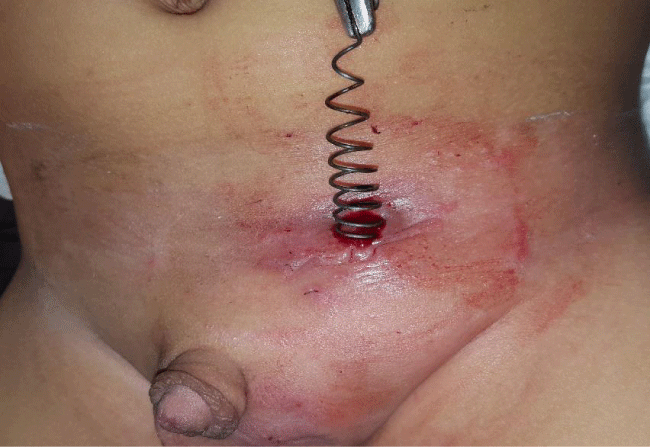Journal of Surgery and Surgical Research
Lasheen technique for lengthening of spermatic cord in management cryptorchidism (Lasheen spiral spring)
Ahmed E Lasheen*
Cite this as
Lasheen AE (2020) Lasheen technique for lengthening of spermatic cord in management cryptorchidism (Lasheen spiral spring). J Surg Surgical Res 6(1): 038-040. DOI: 10.17352/2455-2968.000095Background: Undescended testis is the most common anomaly of male genitalia. In these cases the testis lies at any position other than the normal scrotal position. The goal of surgery is to move the testis to scrotum, but short spermatic cord represent the big problem. Our study offers new technique for lengthening spermatic cord depends on tissue expansion theory.
Methods: Twenty one undescended high inguinal testis patients were included in our study. After complete dissection of testis and spermatic cord of surrounding tissue through inguinal incision. Fine spring made of delicate steel spiral wire was put around cord to produce fine continuous pushing force on testis and spermatic cord toward the scrotum. The inguinal wound was closed with spiral spring in right position and proximal end of spring fixed at the skin by one stitch. After the testis reach normal scrotal position, the spring removed by applied light traction with clockwise rotation on proximal spring end. The mean follow up period was 12 months (ranging from 6 to 18 months).
Results: The mean patients age was 2.5 years (ranging from 1 to 4 years). Congenital inguinal hernia sacs were presented in 15 cases, which excised during surgery. The time needed for putting the testis at the bottom of scrotum ranged from 3 to 4 weeks. The testis was normal in position, vasculature, and size during follow up period by manual examination and Doppler study.
Conclusion: Lasheen technique for lengthening of spermatic cord is safe, easy, and effective in management of undescended testis.
Introduction
Cryptorchidism in Greek language means hidden testis. In undescended testis, the testis lies at any site other than normal scrotal position [1]. This condition occurs in 0.8 – 1.2 % of boys at 1 year old [2]. About 80 % of undescended testis is palpable (inguinal location) while 20 % non-palpable (intra-peritoneal location) [3]. Surgical treatment of undescended testis is indicated at first year to avoid risk of infertility, malignancy, testicular trauma, and psychological stigma on patients and their parents [4]. The goal of surgical treatment is to move normal anatomical testis to normal scrotal position [5]. But, in most cases the spermatic cord is short preventing to achieve this aim [6]. In our study, tissue expansion theory was used for lengthening spermatic cord by Lasheen spiral spring in novel technique [7].
Patients and methods
Twenty one patients with palpable high inguinal undescended testis were included in our study, with mean age 2.5 years (ranging from 1 to 4 years). The study idea was approved by Ethical Committee of General Surgery Department, Zagazig University, Egypt at Augusts 2018. Informed consent was obtained from the parents of all cases, and study beginning at September 2018 for February 2020. All patients subjected to general and local inguinoscrotal examinations, and routine laboratory investigations. Inguinoscrotal ultrasonography was done to confirm diagnosis and evaluate condition before surgery for all cases. Congenital inguinal hernia sacs were presented in 15 cases.
Surgical procedure
Lasheen spiral spring was prepared by corresponding author from fine steel wire. The distance between each rotation of spiral spring about 0.5 cm and its length equal to distance between internal inguinal ring and bottom of scrotum. The diameter of spiral spring is equal to diameter of spermatic cord, to be just contact with cord and preventing testis to go inside it. Under general anesthesia, inguinal incision at lower abdominal crease was done. The testis and spermatic cord were dissected maintaining on all cord contents (cremasteric muscle and fascia), and hernia sac excised if present. The suitable spiral spring in diameter equal to cord thickness and in length equal to distance between internal inguinal ring and bottom of scrotum. After complete dissection, the suitable spring was put in right position from testicular spermatic cord end by clockwise rotation until reach the internal inguinal ring Figure 1. The presence of Lasheen spiral spring produces fine continuous pouching force on the testis and cord toward the bottom of scrotum. The inguinal wound was closed after putting the testis and cord with spiral spring in normal pathway, and the proximal spring end appears and fixed by one stitch on inguinal skin Figure 2. All cases received broad spectrum antibiotics, and anti-inflammatory and analgesic drug for one week. After, lengthening of spermatic cord and testis reached scrotal bottom (ranging from 3 to 4 weeks) higher undescended testis level need more time to descend, the spiral spring removed by application fine traction with clockwise rotation on proximal end of spring under light sedation Figure 3. Mean follow up period was 12 months (ranging from 6 to 18 months) by local inguinoscrotal examination and ultrasonography.
Results
Preoperative inguinoscrotal ultrasonography evaluation showed testis size and vasculature within normal. The dissection of spermatic cord must be maintaining on all layers of cord (cremasteric muscle and fascia) to protect vessels and vas deference from any trauma. The mean time needed to reach the viable testis to the bottom of scrotum was 3.3 weeks (ranging from 3 to 4 weeks). Higher testis level (shorter spermatic cord) needs more time (4 weeks) to descend to normal scrotal position. Removal of spiral spring after the testis reaching scrotum bottom, needs light sedation to keep boy motionless. Also, the starting of spiral spring removal needs some traction with clockwise rotation until proximal spring end come out of skin, then only clockwise rotation enough to complete come out of spring. No bleeding or any complication was observed during removal. All cases show normal testis in anatomy, vasculature and in position be local examination and inguinoscrotal ultrasonography and in comparison with testis in other side during follow up period. Our technique is well tolerated by all patients.
Discussion
The aim of undescended testis treatment is to move viable testis to normal scrotal position, up to now standardized surgical technique for Cryptorchidism has not been reached [8,9]. The best time to perform orchiopexy is between 6 to 12 months of age [10]. Many operative procedures were presented for treatment of Cryptorchidism whoever palpable or non-palpable testis [11,12]. All these procedures faced short spermatic cord problem by producing traction on testis and spermatic cord by sutures for some time and make procedure multiple stages. This type of traction by sutures is strong and for short time, may be leading traumatic injury for testis and cord, and no enough cord lengthening [13]. Our technique for lengthening of spermatic cord depends on tissue expansion theory. This theory states that, any living tissue put under controlled tension for enough time will produced cellular hyperplasia and hypertrophy [14,15]. In our technique the Lasheen spiral spring produce fine and continuous pushing force on testis and spermatic cord until reaching the testis to bottom of scrotum without injury to cord contents and testis. Our procedure not produce traumatic injury for cord and testis by maintaining on all layers of cord during dissection specially cremasteric muscle and fascia, and pushing force of lasheen spiral spring is fine (not strong) and continuous from first moment of application until testis reaching scrotum bottom.
Conclusion
Lengthening of spermatic cord by using Lasheen spiral spring is safe, effective, and has short learning curve in management of cryptorchidism.
- Stredele R, Apfelbeck M, Mainusch M, Lellig K, Karl A, et al. (2018) Undescended testis : current pathways of diagnostics and treatment. MMW Fortschr Med 160: 58-61.Link: https://bit.ly/2LLmsLr
- Neheman A,Levitt M, Steiner Z (2019) A tailored surgical approach to the palpable undescended testis. J Pediatr Uro 15: 59 e1- 59 e9.Link: https://bit.ly/2WGtzLE
- Marret JB, Ravasse P, Guleryuz K, Haffreingue A, Rod J (2017) Experience of single scrotal approach for recurrent undescended testis after primary orchiopexy or inguinal surgery. Prog Urol 27: 93-97.Link: https://bit.ly/3e0gjHG
- Lasheen AE, Salim A, Hefny MR, Al-Bakly E (2004) External tissue expansion successfully achieved using negative pressure. Surg Today 34: 193-196. Link: https://bit.ly/3dWI5Vk
- Abbas T, Hayati A, Ismail A, Ali M (2012) Laparoscopic management of intra-abdominal testis: 5-year single-centre experience a retrospective descriptive study. Minimally invasive surgery 2012: 878509. Link: https://bit.ly/3g52MAo
- Guo J, Liang Z, Zhang H, Yang C, Pu J, et al. (2011) Laparoscopic versus open orchiopexy for non-palpable undescended testes in children : a systemic review and meta-analysis. Pediatr Surg Int 27: 943-952. Link: https://bit.ly/2Zity2j
- Chan E, Wayne C, Nasr A (2014) Ideal timing of orchiopexy a systematic review. Pediatr Surg Int 30: 87-97. Link: https://bit.ly/3cLSgfg
- Thorup J, Cortes D (2019) Surgical management of undescended testis – timetable and Outcome : a Debate. Sex Dev 13: 11-19. Link: https://bit.ly/2TkxITi
- Penson D, Krishnaswami S, Jules A, McPheeters ML (2013) Effectiveness of hormonal and surgical therapies for Cryptorchidism : a systematic review. Pediatric 131: 1897-e1907. Link: https://bit.ly/2zPh47C
- Bergbrant S, Omling E, Bjork J, Hagander L (2018) Cryptorchidism in Sweden: A Nationwide study of prevalence, operative management, and complications. J pediatr 194: 197-203. Link: https://bit.ly/2ZfVEei
- Lasheen AE (2006) External tissue expansion using negative pressure in upper-extremity reconstruction. J Hand Surg Am 31: 1694-1696. Link: https://bit.ly/2Zjbipy
- Lasheen AE, Saad K, Raslan M (2009) External tissue expansion in head and neck reconstruction. J Plast Reconstr Aesthet Surg 62: e251-e254. Link: https://bit.ly/2zb8osa
Article Alerts
Subscribe to our articles alerts and stay tuned.
 This work is licensed under a Creative Commons Attribution 4.0 International License.
This work is licensed under a Creative Commons Attribution 4.0 International License.




 Save to Mendeley
Save to Mendeley
